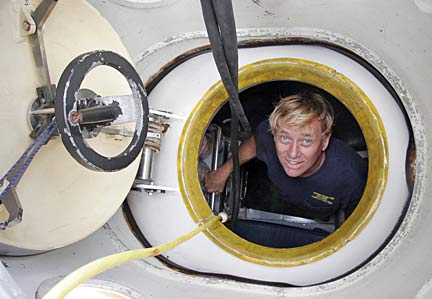
|
Deep-sea discoveries
UH scientists find extreme
life forms near active
submarine volcanoes
University of Hawaii scientists saw an underwater spectacle of barnacles with footlong necks, giant mussels and unusual sights such as chimneys and towers of minerals and bubbles of carbon dioxide gas streaming "like champagne" from volcanoes.
Alex Malahoff describes the stunning discoveries during the five-month "Darwinian expedition" of deep-diving explorations on 13 active submarine volcanoes between American Samoa and New Zealand.
"Now, the fun starts," the Hawaii Undersea Research Laboratory director said yesterday, referring to the analysis of volumes of scientific data collected from unknown volcanoes in the "New Zealand American Submarine Ring of Fire Expedition."
University of Hawaii microbiologist Maqsudul Alam has already identified 27 new species of extremophile bacteria -- which live in extreme conditions such as geothermal and hydrothermal areas -- from samples, Malahoff said.

Mussels and crabs occupy Monowai Volcano. University of Hawaii scientist Alex Malahoff says the submarine volcanoes between Samoa and New Zealand form "the world's greatest underwater laboratory, a natural lab" that could replicate conditions on other planets.
Terry Kerby, chief submersible pilot of the Hawaii Undersea Research Lab submersible Pisces V, peered through the top hatch cover yesterday. The 13-ton craft can go 6,000 feet deep.
Scientists from six research institutions in Germany, New Zealand, the mainland and Hawaii explored volcanoes in a line stretching 1,000 miles between Samoa and New Zealand.
"In 27 years of diving, this was definitely the highlight," said Terry Kerby, HURL operations director and chief pilot who conducted the pioneering dives without a hitch.
"It was amazing. Every dive was pure exploration," he said, describing incredible sights. "Each volcano had a different surprise to throw at us."
The mother ship Ka'imikai-O-Kanaloa left Hawaii on March 18 with HURL submersibles Pisces V and Pisces IV and returned Aug. 5 with scientists calling the 10,000-mile expedition an extraordinary success.
The international scientists collected samples to study the chemistry, geology, mineral formation, hydrothermal vents and extremophile microorganisms in previously unexplored South Pacific volcanoes.
"For me, it was the expedition of a lifetime," said Malahoff, veteran of many diving expeditions. "The highlight was that we pulled it off," he said, explaining it took three years of planning.
He took sabbatical leave from the University of Hawaii in 2002 to be chief executive of the Institute of Geological and Nuclear Sciences Ltd. in Wellington, New Zealand, and organize the expedition with a consortium of institutions, agencies and funding.
The total cost was $3.5 million, contributed by New Zealand and Germany scientists and National Oceanic and Atmospheric Administration programs.
Malahoff said the expedition was "proof of concept of the ship, getting out of the box in Hawaii, proving what we could do by jumping out of the box to the southern ocean, to the other side of the world."
Because of the hazards of unknown volcanic terrain, two pilots went on each dive with a scientific observer.
Kerby said 18 years of diving on Loihi, an underwater volcano off the Big Island, "was great training" to prepare for the first extensive international, multi-disciplinary expedition to the remote submarine volcanoes.
He said 61 science dives were completed to water depths of 5,000 feet, including 41 on submarine volcanoes never seen from manned submersibles.
Scientists had done research on some of the volcanoes from ships or with dredges but they didn't know what was really going on until they saw them with the submersibles, Kerby said. "Scientists said they're not going to guess any more."
The mother ship weathered several raging South Pacific storms with 70-mph winds and 30-foot seas with no problems.
Hydrothermal vent temperatures in the Kermadec Island Arc volcanoes range from 400 to 600 degrees Fahrenheit.
Kerby described "incredible sulfur deposits" with venting and "life teeming all around it, with thousands of shrimp, mussels and tubeworms."
Malahoff said the volcanoes are one of the greatest contributors to hot house gases entering the atmosphere because of emissions of carbon dioxide gas streaming into the seawater.
He said the submarine volcanoes between Samoa and New Zealand form "the world's greatest underwater laboratory, a natural lab" that could replicate conditions on other planets.
The scientists will get together in October to discuss their findings and, possibly, the next expedition.
Acting HURL Director John Wiltshire said they're talking about revisiting the volcanoes in three years "because it is so exciting."
The greatest hazard for deep-diving submersibles is getting entangled in fishing nets or lines, he said, noting the recent case of the Russian mini-submarine ensnared in an undersea cable.
With a second submersible, he said, "We have our own rescue capability."
E-mail to City Desk
[News] [Business] [Features] [Sports] [Editorial] [Do It Electric!]
[Classified Ads] [Search] [Subscribe] [Info] [Letter to Editor]
[Feedback]
